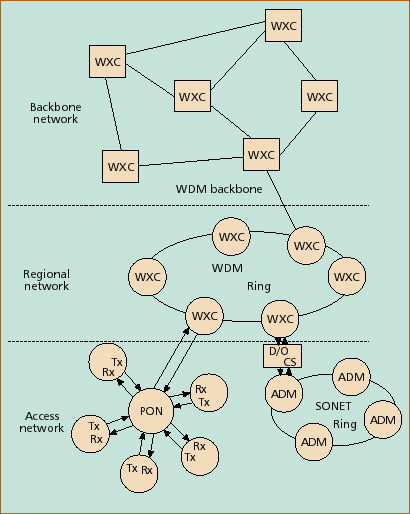| |
The vision-an
all-optical network
Looking at the
evolution of communication networks and standards, they seem to
become more and more complex (and hence less manageable-as human
beings!) as time goes by. This trend is due in part to the increase
in their sizes and bit rates, but mainly to the diversity of the
traffic they carry and services they support.

Figure 1 - An
all-optical network
The vision of WDM
optical networks offers a change in this course of evolution into
much simpler network architectures. Their transparency, abundance in
resources, and passive nature may eliminate the need for
sophisticated mechanisms to optimize the utilization, control, and
management of integrated networks. The architectural simplicity is
achieved through traffic segregation as opposed to the current trend
of traffic aggregation (Fig. 2).

Figure 2 -
Optical layers and digital clients
All that remains
is to concentrate on the endpoints, namely, how to design computers
that can make use of so much bandwidth. Even more important, what
new applications are now enabled by these bit rates?
In the futuristic
scenario depicted in Fig. 1, wherein the fiber infrastructure is
extended to the home (Fig. 3), and in which we can make efficient
use of the thousands of wavelengths that theoretically may be
multiplexed into a single fiber. Then the global network would be
made of fibers interconnected by optical cross-connects, with
optical multiplexers at the endpoints. This entire network may be
viewed as a huge, sophisticated piece of glass, almost passive in
terms of electrical power. When end user X wishes to communicate
with end user Y, X requests the network control entity to establish
the connection. The network then assigns a wavelength to this
connection, sets the switches along the path to support it, and
informs both X and Y of the existence of this new connection. Here
ends the role of the network in the connection, as opposed to
conventional networks in which the network takes an active part in
the transfer of the data. Now, when user X sends a light encoded
signal on wavelength, it is optically routed from X to Y, received
optically at Y, and converted to the electrical domain, to be
processed by Y's application. The endpoints of the connection now
have an ultra-high-speed, low-noise pipe between them, equivalent to
a private fiber that serves them exclusively. The network, acting as
a passive piece of glass, is sensitive neither to the protocol that
X and Y choose to use nor to the bit rate. It may even be
insensitive to the nature of the data (digital or some analog
signal). As a result, there need only be a handful of simple
protocols of which the network will be aware (and thus will have to
be standardized). The rest is up to the users.

Figure 3 – OTN
physical topology.
Contrast this
scenario with the complexity and extensive monitoring and management
required by "traditional" networks, with SDH setting the current
record, probably to be eclipsed by broadband integrated services
digital network (B-ISDN)/ATM. It is enough to see how much
standardization effort is put into other alternatives as such IP and
MPLS for high-bandwidth integrated networks to realize the promise
that optical networks provide.
As is always the
case with vision, reality tells a different story, which we outline
in the rest.
|
|






